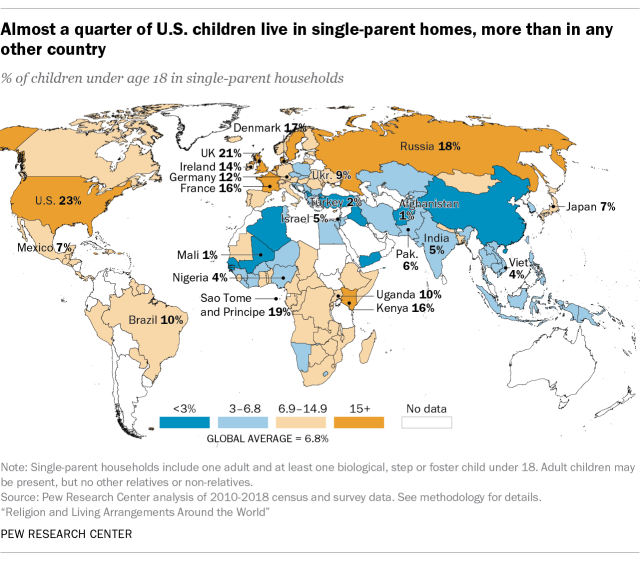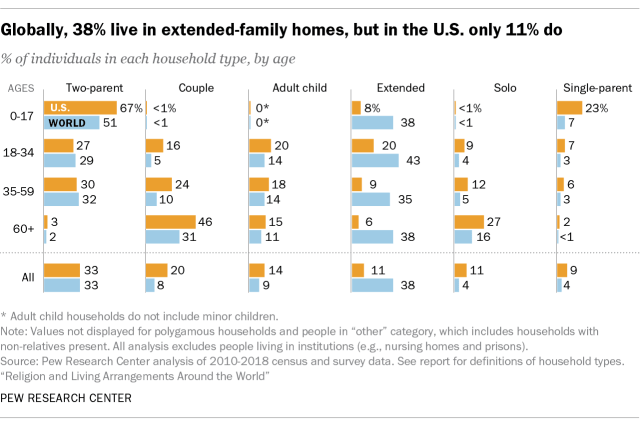Martin H Lund Madison Wi American Family Children's Facebook
For decades, the share of U.S. children living with a single parent has been rising, accompanied past a decline in marriage rates and a ascension in births exterior of matrimony. A new Pew Research Heart written report of 130 countries and territories shows that the U.S. has the world's highest charge per unit of children living in single-parent households.
Nearly a quarter of U.S. children under the age of 18 live with one parent and no other adults (23%), more than than 3 times the share of children around the world who do so (7%). The report, which analyzed how people's living arrangements differ by religion, as well plant that U.Southward. children from Christian and religiously unaffiliated families are well-nigh equally likely to live in this blazon of organisation.
In comparison, 3% of children in Prc, 4% of children in Nigeria and 5% of children in Republic of india live in unmarried-parent households. In neighboring Canada, the share is 15%.

While U.S. children are more likely than children elsewhere to live in unmarried-parent households, they're much less likely to alive in extended families. In the U.S., viii% of children live with relatives such as aunts and grandparents, compared with 38% of children globally.
Researchers have different ways of categorizing single-parent households. In this written report, single-parent households take a sole developed living with at to the lowest degree one biological, stride or foster child under age 18. Some other organizations, including the U.S Demography Bureau, also include households that have grandparents, other relatives or cohabiting partners present.
Economic well-existence a factor in household size
Effectually the earth, living in extended families is linked with lower levels of economical evolution: Financial resources stretch further and domestic chores such every bit childcare are more easily accomplished when shared amidst several adults living together.
The U.South., similar other economically avant-garde countries, peculiarly in Europe and northern Asia, has relatively small households overall. The average person in the U.South. lives in a abode of three.4 people – which is less than the global average of 4.9, but slightly higher than the European average of three.i. In the U.Due south., Christians (three.four), the unaffiliated (3.two) and Jews (3.0) live with roughly the same number of household members.
However, household sizes vary past age – the boilerplate U.S. child under 18 lives in a household of 4.half-dozen members, while the average adult age threescore or older only lives with one other person.
In early adulthood, Americans keep to live with their parents at relatively loftier rates. Adult child households account for 20% of Americans betwixt the ages of eighteen and 34. (Adult kid households are defined as at least one parent living with i son or daughter xviii or older and no pocket-sized children or other family unit members.) Young adults in the U.Southward. are similar to their Canadian counterparts in this regard, and Northward America has a higher share of young adults who live in this arrangement than any other region.
U.S. differs in living arrangements for older adults
Americans likewise differ from others around in the world in their living arrangements afterward historic period 60. Older adults in the U.South. are more likely than those around the globe to age alone: More than than a quarter of Americans ages 60 and older live alone (27%), compared with a global boilerplate of 16%. There are only fourteen countries with college shares of older adults living solitary, and all are in Europe. They include Lithuania (41%), Denmark (39%) and Hungary (37%).
The most common organisation for older U.South. adults, however, is to live every bit a couple without any other children or relatives. Almost half of U.Due south. adults ages sixty and older alive in such households (46%), compared with a global average of 31%. Conversely, older Americans are much less probable to live with a wider circle of relatives. Just six% of older U.S. adults alive in extended-family households, compared with 38% of adults ages 60 and older globally.

Living in smaller households after age 60 is oft tied to national rates of economic prosperity and life expectancy. Older adults are more likely to live lonely or equally couples in countries where an average person can expect to live more 70 years. In countries where lives are shorter, adults 60 and older tend to live with other family members instead. Life expectancy is ofttimes linked to other markers of prosperity within a country, and then older adults who tin can look to alive into their 80s also tend to live in countries where living alone is more than affordable.
And in countries where governments provide fewer retirement benefits or other safety nets, families frequently face up greater responsibility to support crumbling relatives. Cultural norms also play a office, and, in many parts of the world, it is expected that developed children will care for their crumbling parents.
Despite these many differences, U.S. household patterns are besides similar to those in other countries in some ways, and a few of these commonalities are tied to gender.
Women ages 35 to 59 in the U.S., for example, are more than likely than men in the same age group to alive as unmarried parents (9% vs. 2%), a pattern mirrored in every region and religious group around the world.
And women, on average, are younger than their husbands or male person cohabiting partners in every country analyzed. That age gap is 2.2 years in the U.S. and in the rest of the world ranges from 2 years in the Czechia to xiv.5 years in Gambia. Within the U.S., Jewish partners are closest in age, with only one year betwixt them, while Christians and the unaffiliated have an equal gap (two.2 years).
Coupled with women's longer life expectancy, this tendency helps explicate some of the differences in how older men and women in the U.South. live.
More than than half of U.Southward. men ages 60 and older (55%) live with a partner and no one else, while roughly iv-in-ten women (39%) do. And almost a tertiary of women ages sixty and older live alone (32%), while this is true of one-in-five men in the same historic period group (20%).
Note: Run into total methodology.

Stephanie Kramer is a senior researcher focusing on faith at Pew Enquiry Centre.
thornhillactem1984.blogspot.com
Source: https://www.pewresearch.org/fact-tank/2019/12/12/u-s-children-more-likely-than-children-in-other-countries-to-live-with-just-one-parent/
0 Response to "Martin H Lund Madison Wi American Family Children's Facebook"
Post a Comment